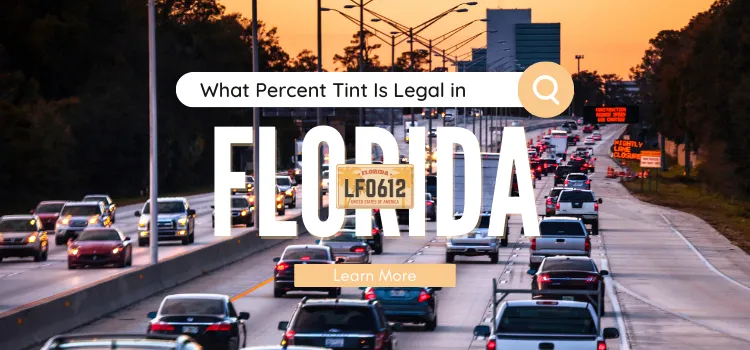Table of Contents
1 Introduction
Window tinting is a popular modification for cars, offering various benefits like privacy, UV protection, and a cooler interior. However, before you rush to tint your vehicle’s windows, it’s crucial to understand the laws and regulations that govern this practice. In this article, we’ll explore the question: “What percent tint is legal in Florida?” We will provide you with a complete summary of Florida’s window tint laws to assist you in staying on the right side of the law while still enjoying the benefits of tinted windows.

2 Understanding Window Tint Percentage
What Is Window Tint?
Window tint is a thin, multi-layered film applied to the inside of vehicle windows. It is designed to reduce the amount of visible light, infrared radiation, and UV rays that enter the vehicle. Tinted windows can enhance privacy, protect the vehicle’s interior, and improve the overall driving experience.
Importance of Window Tint Percentage
The percentage of visible light that a window tint allows to pass through is known as the Visible Light Transmission (VLT) percentage. This percentage is a crucial factor in determining the legality and effectiveness of window tint. Different states have varying VLT limits, making it essential to know your local regulations.
3 Florida’s Window Tint Laws
Florida, like many other states, has specific regulations regarding window tint percentage. It is essential to understand these laws to ensure compliance. Let’s break down Florida’s window tint laws:
Front Side Windows
Florida law permits a minimum of 28% VLT on front side windows. This means that at least 28% of visible light must pass through the window. Tint darkness levels below this threshold are considered illegal.
Back Side Windows
Unlike front side windows, rear side windows, and the rear window can have any level of darkness, provided the vehicle has dual side mirrors. This flexibility allows for more extensive tinting in the rear of the vehicle.
Windshield Tint
Florida law prohibits the application of window tint on the windshield, except for a non-reflective tint along the top portion of the windshield, commonly known as the “eyebrow.” This tint should not extend more than six inches below the top of the windshield.
Reflectivity Limits
In addition to darkness levels, Florida regulates the reflectivity of window tint. The law states that window tint should not have more than a 25% reflectivity rate. High reflectivity can be distracting to other drivers, making it essential to stay within this limit.
4 Tint Percentage for Medical Exemptions
Florida offers exemptions to its window tinting regulations for individuals with specific medical conditions. To qualify for a medical exemption, you must have a medical statement from a licensed physician explaining the condition and the need for window tinting. However, even with a medical exemption, the tint darkness must still allow at least 28% of visible light.
5 Penalties for Tint Violations
Driving with illegal window tint in Florida can result in penalties, including fines and potential points on your driver’s license. It’s essential to comply with these regulations to avoid legal troubles and ensure safety on the road.
6 Advantages of Legal Tint Percentage
While some may be tempted to go darker than the legal limit, there are advantages to adhering to the law. Legal tint percentage ensures that you maintain good visibility both during the day and night, reducing the risk of accidents. Additionally, it avoids potential legal issues and costly fines.
7 FAQs
Q: Can I tint my front side windows darker than 28% VLT if I have a medical exemption?
A: No, even with a medical exemption, the minimum tint darkness for front-side windows in Florida remains 28% VLT.
Q: Are there any restrictions on the color of window tint in Florida?
A: Florida law does not specify a particular color requirement for window tint. However, the tint should not be red, amber, or any color that could obstruct the driver’s view.
Q: Do I need to carry my medical exemption documentation with me while driving?
A: Yes, if you have a medical exemption for window tint, it’s advisable to keep the documentation in your vehicle at all times. Law enforcement may request to see it during a traffic stop.
Q: Can I have my windows tinted darker by a professional tinting service?
A: It’s essential to ensure that any professional tinting service you use adheres to Florida’s legal limits for window tint darkness and reflectivity. Failure to comply could result in legal consequences for both you and the service provider.
Q: Are there any additional regulations for commercial vehicles?
A: Commercial vehicles are subject to the same window tint regulations as personal vehicles in Florida. However, it’s essential to consult the Florida Department of Highway Safety and Motor Vehicles for any specific commercial vehicle guidelines.
8 Conclusion
In Florida, adhering to window tint regulations is essential for legal compliance and road safety. Understanding the answer to the question, “What percent tint is legal in Florida?” is crucial for all vehicle owners. Remember to maintain the minimum 28% VLT on front side windows, be mindful of reflectivity limits, and consider medical exemptions if needed. By following these guidelines, you can ensure a trouble-free driving experience in the Sunshine State.











